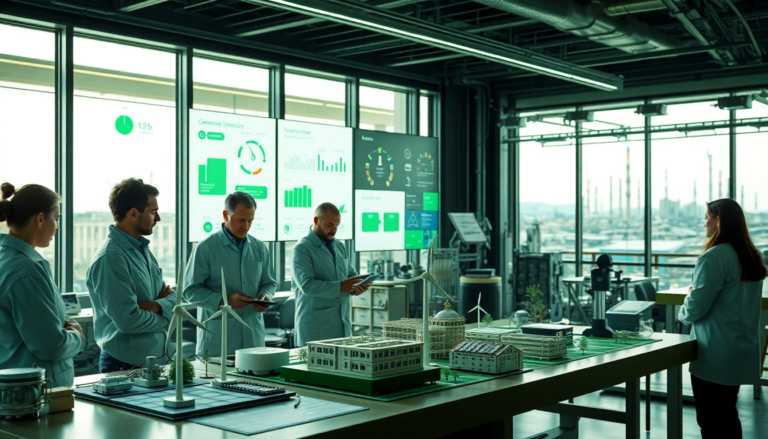Argomenti trattati
The recent closure of the 2024 Innovation Fund calls marked a significant milestone, with a staggering 373 project proposals submitted. This overwhelming response reflects the resilience and ambition of the European industry in its pursuit of climate neutrality while simultaneously enhancing its competitive edge. With a total funding pool of up to €3.4 billion sourced from the EU Emissions Trading System (EU ETS), the stage is set for groundbreaking clean technologies to take flight.
Net-zero technologies call: A closer look
Launched on December 3, 2024, the Net-zero technologies call drew an impressive 359 applications. Collectively, these proposals sought a whopping €21.7 billion in support, emphasizing a demand that eclipses the available budget of €2.4 billion by more than ninefold. It’s interesting to think about the sheer scale of ambition here; it’s as if the industry is saying, “We are ready to leap into the future, just give us the means!” The potential impact? Over the first decade of operation, these projects could prevent the emission of approximately 1.8 million tonnes of CO2.
Under the umbrella of the Clean Industrial Deal and aligned with initiatives like the Wind Package and Industrial Carbon Management Strategy, the IF24 Call is designed to strengthen the business case for investments in decarbonisation and clean technology. It’s not just about funding; it’s about creating an ecosystem that fosters innovation. The topics for proposals spanned various key decarbonisation areas, encompassing energy-intensive industries, renewable energy, and energy storage, among others. I remember when discussions around these topics were merely theoretical, but now we are witnessing tangible actions!
The electric vehicle battery manufacturing call
Among the proposals, the call dedicated to electric vehicle battery cell manufacturing is particularly noteworthy. For the first time, the Innovation Fund (IF24 Battery) allocated up to €3 billion in EU funding specifically for the European battery manufacturing industry. This initiative aims to reduce dependency on foreign suppliers and bolster the resilience of the green mobility sector. The battery manufacturing sector is critical, given the ongoing shift towards electric vehicles.
The response to this call was robust, with 14 proposals submitted from various EU countries. Germany led the pack, closely followed by France, Bulgaria, and Poland. The diversity of projects indicates a readiness and eagerness within the industry to innovate. The types of technologies proposed include Lithium-ion nickel magnesium and cobalt technologies (Li-Ion-NMC), Solid State, and Lithium-Ion-Iron Phosphate (Li-ion-Iron). Collectively, these projects aim to prevent an equivalent of 138 million tonnes of CO2 emissions over a decade. This is not merely about numbers; it’s about reshaping our world, one battery at a time.
The evaluation and future steps
As the dust settles on the proposal submissions, the evaluation process is now in full swing. Following thorough eligibility checks, external experts will assess each proposal against established criteria. These include the degree of innovation, potential for greenhouse gas emission reduction, and overall cost efficiency. The results of this rigorous process will be unveiled in the latter half of 2025. It’s a waiting game, but the anticipation is palpable.
Interestingly, all projects that meet the evaluation criteria will receive a STEP Seal from the Commission, a form of recognition that could open doors for additional funding from various public or private sources. This initiative is a clever way to amplify support for projects that might not receive immediate funding but still hold tremendous potential. The Commission is also urging member states to adopt ‘Grants-as-a-Service’ to streamline financial support for promising projects. It’s a win-win situation — fostering innovation while maximizing resources.
Investment and support for future projects
In collaboration with the European Commission, the European Investment Bank will extend Project Development Assistance (PDA) to support both those projects that were not selected for funding and new initiatives aspiring to apply. This tailored technical and financial advisory support could be a game-changer for many projects. I can’t help but feel excited about the future; with such support mechanisms in place, we are nurturing a fertile ground for innovation.
As we look at the bigger picture, the Innovation Fund, fueled by auction revenues from emission allowances under the EU ETS, is a vital driver of investment in cutting-edge, low-carbon technologies. With around €12 billion already committed since 2021, it’s clear that Europe is serious about its transition to climate neutrality. The impressive array of projects being funded across the European Economic Area (EEA) is a testament to this commitment.
Reflecting on this journey, one can’t help but feel a sense of optimism. The industry is not just responding to regulatory pressure; it is embracing the challenge with open arms. As many know, the road to a sustainable future is fraught with challenges, but with the right investments and innovations, we are on the brink of a breakthrough. The question remains: how far are we willing to go to secure a cleaner planet for future generations?

